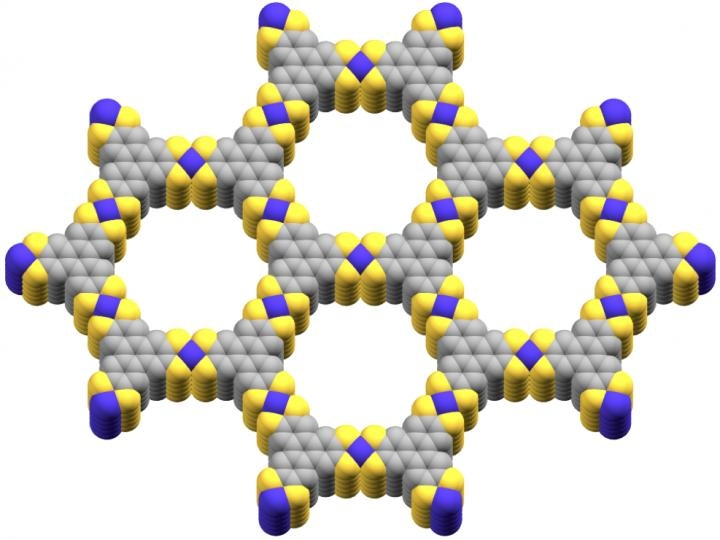Oct 13 2017
Researchers are keen to discover the next generation of materials that can catalyze a transformation in renewable energy harvesting and storage.
 The cobalt-based metal-organic framework used by the USC scientists, with purple representing cobalt, yellow representing sulfur and gray representing carbon. (Credit-Smaranda Marinescu)
The cobalt-based metal-organic framework used by the USC scientists, with purple representing cobalt, yellow representing sulfur and gray representing carbon. (Credit-Smaranda Marinescu)
One potential material appears to be metal-organic frameworks. Researchers have used these tiny, ultra-thin, flexible, super-porous crystalline structures to do everything from trapping and converting carbon into fuels to storing hydrogen and other gases. Their major disadvantage has been their lack of conductivity.
Currently, according to USC Researchers, metal-organic frameworks are capable of conducting electricity in the same manner as metals do.
This paves the way for metal organic-frameworks to soon be able to efficiently store renewable energy at a very large, almost unimaginable scale.
"For the first time ever, we have demonstrated a metal-organic framework that exhibits conductivity like that of a metal. The natural porosity of the metal-organic framework makes it ideal for reducing the mass of material, allowing for lighter, more compact devices" said Brent Melot, assistant professor of chemistry at the USC Dornsife College of Letters, Arts & Sciences.
Metallic conductivity in tandem with other catalytic properties would add to its potential for renewable energy production and storage.
Smaranda Marinescu, Assistant Professor of Chemistry, the USC Dornsife College
The research findings have been published in the July 13th issue of the Journal of the American Chemical Society.
An emerging catalyst for long-term renewable energy storage
Metal-organic frameworks are so porous that they are well-matched for absorbing and storing gases like carbon dioxide and hydrogen. Their storage is extremely concentrated: 1 gram of surface area offers the equivalent of thousands of square feet in storage.
Solar has not yet been greatly exploited as an energy source. The earth receives more energy from one hour of sunlight than is used up in one year by the whole planet, but there is presently no way to use this energy because there is no means to conserve all of it. This intermittency is crucial to virtually all renewable power sources, making it difficult to harvest and store energy unless, say, the wind is blowing or the sun is shining.
If esearchers and industries could one day repeatedly reproduce the capability showcased by Marinescu, it would go a long way to decreasing intermittency, allowing man to finally utilize solar energy an lasting and more permanent resource.
Metal or semiconductor: why not both?
Metal-organic frameworks are 2D structures that have sulfur, cobalt, and carbon atoms. In many ways, they very roughly look like graphene, which is also a very thin layer of 2D, transparent material.
As temperature drops, metals become more conductive. Conversely, as the temperature rises, it is semiconductors that become more conductive.
In the experiments performed by Marinescu's group, they used a cobalt-based metal-organic framework that imitated the conductivity of both a semiconductor and metal at different temperatures. The metal-organic framework built by the Researchers showed its greatest conductivity at both very high and very low temperatures.